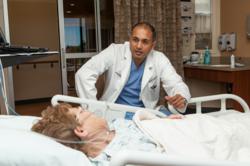
Aberdeen, SD (PRWEB) July 03, 2013
Sanford Aberdeen interventional cardiologist Puneet Sharma, MD, lately produced history by utilizing the CorPath Vascular Robotic System to provide a procedural very first in the nation. For the first time in the United States, Dr. Sharma utilized the vascular-robotic program with an acute heart-attack patient quicker than the national remedy time common.

The Cor Path Robotic Angioplasty was performed on a patient who had seasoned a heart attack and presented to the Sanford Aberdeen emergency division, Dr. Sharma stated. As physicians, we often refer to our approach in terms of the door to balloon time to indicate the time frame from when the patient presents with a heart attack to the completion of the cath procedure. The door to balloon time for this acute heart attack individuals procedure was completed at Sanford Aberdeen Health-related Center in 68 minutes. The acceptable nationwide standard for door to balloon time for a patient experiencing a heart attack is 90 minutes to avert additional heart damage.

The CorPath 200 robotic-assisted method was recently installed at Sanford Aberdeen Medical Center following receiving funding from The Leona M. and Harry B. Helmsley Charitable Trust to advance heart care for the region. The grant supported the purchase and installation of the only Food and Drug Administration (FDA) cleared robotic-assisted technologies to help interventional cardiologists in putting stents and balloons in patients with coronary artery disease (CAD).

Thanks to the generous donation, Sanford Overall health implemented two CorPath 200 robotic-assisted systems, one particular installed in the Sanford Heart Hospital in Sioux Falls and the other at the Sanford Aberdeen Health-related Center. With this installation, Sanford Wellness became the very first in the region to have this technologies and only the fifth and sixth places in the United States.

As shown with the latest process, this technology improves rural access and high quality as fewer sufferers will need to have to travel out of this location for sophisticated specialty care, said Dr. Sharma. Heart disease remains one particular of the leading causes of death for men and ladies in South Dakota. Timely access to emergency cardiac care and survival is partly dependent on access to solutions and technology. The improvement of the CorPath 200 program and the present and future advancements it holds for our individuals at Sanford Aberdeen is a excellent instance of Sanford Healths commitment to this area.

For the duration of a classic catheterization procedure, physicians use x-ray guidance to manually push a catheter through the coronary arteries. The CorPath 200 Technique by Corindus Vascular Robotics enables physicians to have precise robotic assisted movements during these vital heart procedures. The physician utilizes a joystick to perform procedures, precisely advancing catheters, angioplasty balloons and stents to clear the blockage and restore blood flow.

It offers the doctor enhanced visualization and reduces process time. Dr. Sharma also noted that direct patient positive aspects of utilizing the robotic technique contain less x-ray exposure and contrast and greater precision in putting the stent.

About Sanford Aberdeen
The Sanford Aberdeen Health-related Center is a new state-of-the-art hospital which opened in 2012 to meet the developing overall health care needs of the Aberdeen region and region communities. The 48-bed healthcare center is directly attached to the established multi-specialty Sanford Aberdeen Clinic. Sanford Aberdeen Health-related Center is a complete service regional hospital that contains adult and pediatric care, emergency/trauma, labor and delivery, essential care, cardiac cath lab, inpatient and outpatient surgical and procedural places, inpatient and outpatient therapies. For a lot more details, please visit sanfordaberdeen.org.

About The Leona M. and Harry B. Helmsley Charitable Trust
The Helmsley Charitable Trust aspires to increase lives by supporting successful nonprofits in a selection of chosen regions. Given that 2008, when the Trust started its active grantmaking, it has committed a lot more than $ 800 million to a wide variety of charitable organizations. The Trusts Rural Healthcare Program funds innovative projects that use information technologies to connect rural individuals to specialty and emergency medical care, bring the most recent healthcare therapies to patients in remote locations, and offer state-of-the-art education for rural hospitals and EMS personnel. To date, this program has awarded a lot more than $ 172 million to organizations and initiatives in the upper Midwest states of North Dakota, South Dakota, Nebraska, Wyoming, Minnesota, Iowa, and Montana.

###






